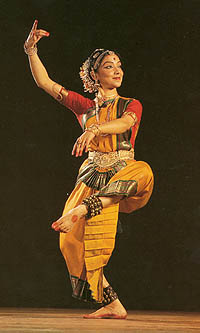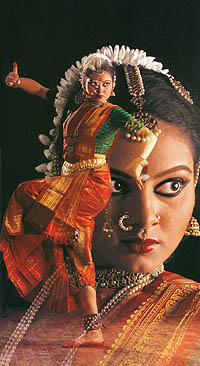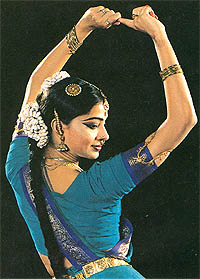Bharatanatyam Style
Bharata Natyam is a subtle and complex form of dance art from state Tamilnad.
This is a dynamic, earthly and very clear dance style. Its distinctive features
are variety of motions with emphasis on foot stamping, jumps and turns. The main
figures are balanced poses with stretched hands and legs that add certain
linearity to the dance. Beauty and power, slow-downs and speed-ups, pure dance
and pantomime are equally felt in this dance. This style is equally good both
for solo and group performance.
Professional dancers deeply understand the ideological and philosophical content
of Indian myths and
 legends,
and besides they possess a perfect command of the technique. The ability to
transfer various forms of a poetical text is a real test for a dancer's mastery.
She/he plays the role of the main heroine of the play and portrays her various
states. A dancer must be a really creative and inspired person to be able to
express the finest nuances of feelings. A dancer's mastery in rendering the
dance contents on different semantic levels attracts the audience attention. In
a solo performance the individuality of interpretation depends on a dancer's age,
training level, artistic taste, experience, knowledge and talent. legends,
and besides they possess a perfect command of the technique. The ability to
transfer various forms of a poetical text is a real test for a dancer's mastery.
She/he plays the role of the main heroine of the play and portrays her various
states. A dancer must be a really creative and inspired person to be able to
express the finest nuances of feelings. A dancer's mastery in rendering the
dance contents on different semantic levels attracts the audience attention. In
a solo performance the individuality of interpretation depends on a dancer's age,
training level, artistic taste, experience, knowledge and talent.
There is a widely spread opinion that the name Bharata Natyam means "Indian
dance". This misunderstanding originates in how this style from state Tamilnad
is generally accepted in both India and abroad. However, the devoted admirers of
this style notice that the name appeared not longer than fifty years ago.
Earlier it was first known as sadir kacheri (sadir stands for a dancer, kacheri
stands for spectators), then as chinnamela (a small audience in contrast to
periyamela - a large audience), and then as dasiatta that derived from devadasis
(female dancers) who performed the dance. The more probable version says that
Bharata consists of the first syllables of the following words: bhava (feeling),
raga (melody) and tala (rhythm) and quasi unites the three pillars on which the
style is based. There is another version according to which Bharata Natyam that
firmly sticks to the behests of Natya Shastra got its name after sage Bharata
the author of this ancient book.
Bharata Natyam traces its roots back to Hinduism and more specifically to Hindu
myths and rituals. This especially manifests itself in the texts chosen for
performance, in sculptural portrayals of dancers in ancient Hindu temples and in the very philosophy of this dance style. The
sculptures in the south Indian temples tell us that both music and dance were
given to people by Gods and Goddesses.
ancient Hindu temples and in the very philosophy of this dance style. The
sculptures in the south Indian temples tell us that both music and dance were
given to people by Gods and Goddesses.
That's why it is quite obvious that the spiritual meaning of Bharata Natyam can
not be ignored. Hinduism is called "a live religion". In every myth there is a
moral that simply teaches the ethics of everyday life and its connection with
the transcendental. Events develop on a very simple human level that has led to
a certain simplification in dance performance. Under such interpretation the
sublime may seem quite materially-minded.
Up to the beginning of the XX century the dance had been the integral part of a
temple ceremony. According to a tradition a local ruler or highest officials
patronized the temple. A dancer, her guru and their musicians were highly
respected and supported by the temple. During religious processions a dancer
walked in front of a horse-drawn vehicle with the idol of a deity. She was
perfectly acquainted with the temple ritual, the rules of offerings and prayers
and played a significant role of tributes carrier to the image of a deity.
A female dancer was revered as the god's wife and her most important duty was
the participation in ceremonies connected with his cult. That reminded the
status of high priestesses in temples of Ancient Greece. She was called a
devadasi, a maidservant. The dance itself besides complex ritual ceremonies used
to be also performed on other occasions in the right time under favorable
circumstances for instance on occasion of a festival, the crowning and marriage
ceremonies, birth of a son or entering a new town or a house. Territories around
temples were considered the only comfortable place where people could gather to
see the dance. A dancer herself was a rich and respected person.
During the British reign the dance starts to lose its ritual purpose. Devadasis
started to dance at princes' courts and in the houses of rich landlords. Poets
in their flowery style glorified the greatness of their patrons and dancers
danced to the lyrics. A temple dancer turned into a court dancer and often used
to have a bad reputation. The complicated political situation in the country and
the new understanding of social and cultural values presented by educated and
prosperous Indians adversely affected their attitude to the art of dance. The
social status of a dancer declined, the shadow was cast upon the very art and
for many years the public was deprived of the pleasure to enjoy Bharata Natyam.
Perhaps it the threat of Bharata Natyam's complete disappearance that caused the
scope of the
 movement
for the revival of the dance and the returning of its one-time glory.
Balasarasvati and Rajalakshmi's initiative was taken up by Rukmini Devi and I.
Krishna. The music academy in Madras made the major contribution to the cause of
the dance revival and put the area for public performances at Balasarasvati'
disposal. The excessive erotic bias was soon equalized, good taste and aesthetic
delicacy returned to Bharata Natyam performance. The first public Rukmini Devi's
performance in 1935 marked the irreversibility of return to the past. movement
for the revival of the dance and the returning of its one-time glory.
Balasarasvati and Rajalakshmi's initiative was taken up by Rukmini Devi and I.
Krishna. The music academy in Madras made the major contribution to the cause of
the dance revival and put the area for public performances at Balasarasvati'
disposal. The excessive erotic bias was soon equalized, good taste and aesthetic
delicacy returned to Bharata Natyam performance. The first public Rukmini Devi's
performance in 1935 marked the irreversibility of return to the past.
Bharata Natyam is a many-facet kind of art. It includes music, poetry, the art
of drama and pantomime. While considering the most important aspect of dance,
nritta (pure dance), first and foremost the body and hands positions and a
dancer's movements in combination with the musical context must be taken into
account. Rhythm, the main constituent part of the dance, interweaves with melody,
that's why it is important to know what music and what rhythms accompany nritta.
Nritta is the heart of the dance style while nritya is its soul. Melody, rhythm
and lyrics are its constant accompaniment and the source of inspiration.
According to "Abhinaya Darpana" which Bharata Natyam's followers still firmly
stick to, there are ten basic body positions. However, nattuvanaras (dance
teachers) do not often use Sanskrit terms and prefer to use simpler Tamil
terminology in class. That's why instead of ayata they use araimandi that simply
means "semi-sitting" in Tamil language. Just the same muramandi means "fully
sitting"; this is the squatting position when a dancer sits on tiptoes with her
knees moved apart. Out of this position a dancer moves into motita when knees
touch the floor in turns or into parshvasuchi when one knee rests against the
floor, or into samasuchi when both knees rest against the floor. Guru and
dancers can interpret and execute these positions in different ways. However,
merely visual perception of the basic positions gives a clear idea of the
stylistic limits of this dance. This is the main structure within which a dancer
works.
The system of arranging adavas, a row of static poses connected with each other
in a certain way to create a motion, was for the first time legibly formulated about forty years ago.
Teaching them was casual, the things still remaining as they are in some schools.
Dancers often studied the subject as a whole considering each motion separately
only when they came across in choreography. The absence of well written manuals
and teachers' excessive haste to finish the course now leads to the situation
when students master the ABC of the style insufficiently. As a result dancers
often have a rather vague idea of the structure of the dance style. Fortunately,
nowadays gurus have started to systematize their syllabuses thus allowing the
students of various schools using them.
create a motion, was for the first time legibly formulated about forty years ago.
Teaching them was casual, the things still remaining as they are in some schools.
Dancers often studied the subject as a whole considering each motion separately
only when they came across in choreography. The absence of well written manuals
and teachers' excessive haste to finish the course now leads to the situation
when students master the ABC of the style insufficiently. As a result dancers
often have a rather vague idea of the structure of the dance style. Fortunately,
nowadays gurus have started to systematize their syllabuses thus allowing the
students of various schools using them.
Rukmini Devi was the first classifier in Bharata Natyam training. She worked out
her own system of "developing adavu" so that a student was able to move from
simple movements to more complex ones gradually: from static figures to the ones
performed in motion; from the motions performed in araimandi to the motions in
more complex positions, then move to turns and jumps and finally to the figures
with a very complex combination of hands' and legs' positions. Her contribution
to Bharata Natyam training is immeasurably great; the variety of motions and
figures in this dance style owes a lot to her talent and creative genius.
During the process of study it is very important to stick to the system when a
student masters every motion by going through three speeds in its performance.
It gives her the feeling of balance and allows mastering the basic rhythm on the
initial phase of study.
The combination of figures in dance allows quick changing of the direction in
body motion. Some figures seem dynamic, the others seem soft; some figures are
performed on-site in the rhythm of dance, the others fall out of it; some
positions provide more freedom to move asides, the others are performed with a
certain purpose of moving into the front from the back of the stage. Jumps and
turns allow carrying out the motions on the floor and the whole stage space. All
this gives choreographer rich opportunities for arranging various compositions.
A good dancer is able to effectively dance even a short nritta combination. A
performance of longer combinations does not prove a dancer's mastery but rather
is the evidence of her stamina and self-control.
Bharata Natyam is based on the karnatak musical system and its rhythmic cycles
or talas. Musical
 accompaniment
must contain rhythmic potential for the pure dance and the corresponding
literary content for the plot dance. Mridangam, the main percussion instrument
in south India has one body unlike the northern tabla that consists of two
separate parts, with lower and higher registers; each one is played on with one
hand. Syllables or rhythmic sounds of mridangam are distinctive characteristics
of Bharata Natyam; they are pronounced or sung as an accompaniment to dance
parts - nritta. accompaniment
must contain rhythmic potential for the pure dance and the corresponding
literary content for the plot dance. Mridangam, the main percussion instrument
in south India has one body unlike the northern tabla that consists of two
separate parts, with lower and higher registers; each one is played on with one
hand. Syllables or rhythmic sounds of mridangam are distinctive characteristics
of Bharata Natyam; they are pronounced or sung as an accompaniment to dance
parts - nritta.
Like the notes in music have their names "sa-ri-ga-ma-pa-dha-ni", so the dance
has its drumming syllables: tat-dhita, taka-dhimi, naka-djham, tadhin-djina etc.
Various combinations of these phrases during their sounding add savour and
expressiveness to the fragments of pure dance, nritta. Combinations of these
phrases are called jatis. In every dance performance the virtuosity and mastery
of nattuvanar are estimated by the correct arrangement of jatis into complex
rhythmic figures in a certain timing loop.
The word tala derives from the word denoting "palm surface" by which the rhythm
is beaten. There is a version about the word tala according to which it consists
of the first syllables of two words: tandava and lasya that romantically means
the junction of male and female principles or rhythm forms. There are seven
talas. Each can use any of the five variants of jati that gives the total of 35
various talas.
In the past a dancer was accompanied by an orchestra placed behind her on stage.
It consisted of one or two nattuvanars who played cymbals and sang songs, a boy
whose only task was keeping up the monotonous sound or shruti (tone pitch) with
the help of a small box, and a clarinetist. Clarinet once being rather popular
was later replaced by flute. This was demanded by "Abhinaya Darpana" and this
situation had preserved up to the 1920s when stage conditionality changed. In
today's concerts musicians sit to the dancer's right closer to the front edge of
the stage. The orchestra consists of a nattuvanar, a female singer, a tanpur
player that replaced the primitive box shruti, a flutist, a violinist and a vina
player.
Performers of Indian classic dances are very effective in their outward
appearance. A Bharata Natyam dancer is not exclusion. She wears a bright costume
and so many jewels that you hardly understand how she simply moves let alone
dancing enthusiastically.
A dancer's hair is plaited with entwined flowers and ornaments. The traditional
headdress consists of a long and flat hoop that envelopes the head and edges the
face and two big hairpins on top of the head on both sides of the middle hair parting that symbolize the sun and the moon.
These red and golden decorations look extremely advantageous against black hair.
A dancer also puts on golden bracelets, small chains on hands, a necklace with a
big pendant in the middle, a belt, foot bracelets and small bells. Similar
decorations can be found with performers of other Indian classic dance forms.
The metal used for decorations may vary depending on the dance style as well as
the tracery and the stones used. In Bharata Natyam they use red, white and green
gemstones framed in gold or gilded silver.
on both sides of the middle hair parting that symbolize the sun and the moon.
These red and golden decorations look extremely advantageous against black hair.
A dancer also puts on golden bracelets, small chains on hands, a necklace with a
big pendant in the middle, a belt, foot bracelets and small bells. Similar
decorations can be found with performers of other Indian classic dance forms.
The metal used for decorations may vary depending on the dance style as well as
the tracery and the stones used. In Bharata Natyam they use red, white and green
gemstones framed in gold or gilded silver.
A dancer's costume is a rich sari from Kanchipuram. Kanchipuram is the town
famous for its wonderful silk saris with a traditional ornamentation embroidered
with golden thread along the edges. For stage performances contrasting colours
are preferable so that the colour of the ornamentation could stand out against
the background of a sari. Mustard-yellow, green and red colours are usually
associated with Bharata Natyam dance.
A sari is worn in different ways; its length is as a rule a little below calves.
Costumes imitating sari are in fashion now. Thanks to the costume a dancer looks
neat and gets rid of the necessity to wind six yards of thick material around
her.
Based on the book "Rhythm In Joy" by Leela Samson
| 